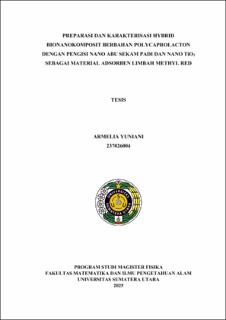Preparasi dan Karakterisasi Hybrid Bionanokomposit Berbahan Polycaprolacton dengan Pengisi Nano Abu Sekam Padi dan Nano TiO2 Sebagai Material Adsorben Limbah Methyl Red
Preparation and Characterization of Polycaprolactone-Based Hybrid Bionanocomposite With Nano Rice Husk Ash and Nano TiO₂ Fillers as Methyl Red Waste Adsorbent Material

Date
2025Author
Yuniani, Armelia
Advisor(s)
Frida, Erna
Humaidi, Syahrul
Metadata
Show full item recordAbstract
Wastewater contamination by synthetic dyes such as Methyl Red poses serious environmental and health risks, necessitating effective remediation methods. This study investigates an eco-friendly hybrid bionanocomposite based on polycaprolactone (PCL), reinforced with rice husk ash and titanium dioxide (TiO₂) nanoparticles, for the degradation of the textile dye Methyl Red. Silica (SiO₂) was synthesized from rice husk ash calcined at 800°C for 6 hours and milled at 300 rpm for 1 hour. Nano rice husk ash particles were produced via co-precipitation. The composites were characterized using SEM-EDX, FTIR, XRD, UV-Vis spectroscopy, and biodegradation tests. XRD analysis using the Scherrer equation indicated crystal sizes ranging from 19.01 nm (S0 composite) to 27.25 nm (S2 composite). The FTIR spectra showed absorption peaks associated with Ti–O (669.29 cm⁻¹), Si–O (970.19 cm⁻¹), and C–H (2960.73 cm⁻¹) bonds. Photodegradation tests revealed a color change of Methyl Red from red to transparent, with the highest degradation efficiency of 93.55% achieved by the S1 composite after 45 hours of irradiation. All samples exhibited significant mass reduction, confirming the composites’ potential as biodegradable and sustainable materials for efficient wastewater treatment applications.
Collections
- Master Theses [310]
